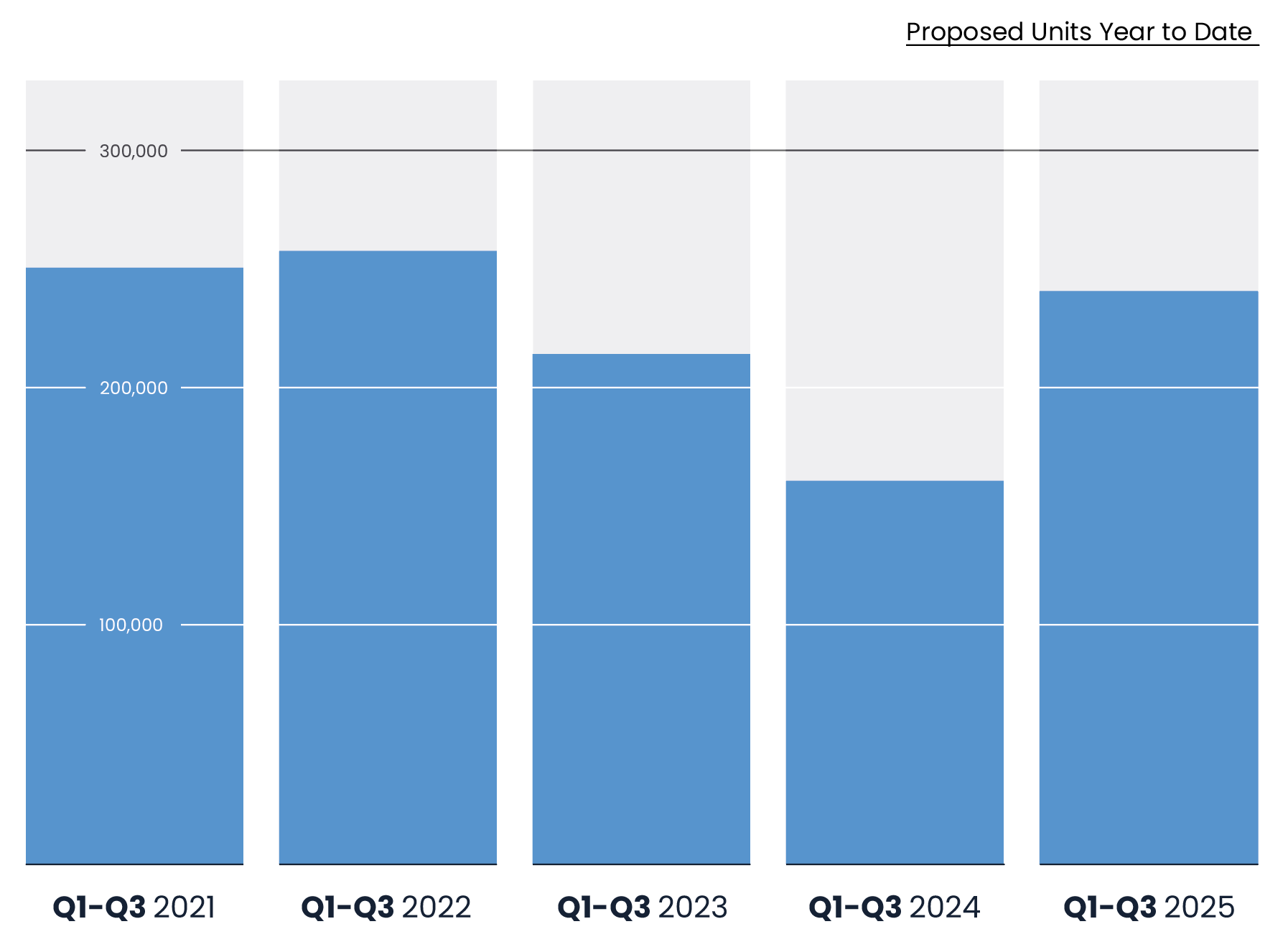Panorama on housing : delivery challenges, but our data shows signs of momentum

BBC’s Panorama this week tackled one of the biggest questions facing the built environment and the UK’s housing crisis: can Britain really deliver 1.5 million new homes by the end of the parliamentary term?
It was a poignant and in-depth look at the pressures shaping housing delivery today; from funding and skills shortages to debates around grey belt land and environmental constraints. The programme concluded on a somewhat sobering note: planning permissions are at a “record low”, and as Justin Rowlatt observed, “it will take years to fix this country’s housing crisis.”
Housing Secretary Steve Reed reaffirmed his commitment to hitting the target during the programme - saying he expected his own job to be ‘on the line’ if it isn’t met - while Chief Executive of the Home Builder’s Federation Neil Jefferson cautioned that the goal is looking “increasingly distant.”
Our data - the earliest indicator of national development intent – did not feature in the programme - but tells a decidedly more hopeful story.
As providers of the national planning application service, processing over 95% of applications across England and Wales, TerraQuest’s Planning Application Index (Q3 2025) reveals strong signs of renewed developer intent and early-stage momentum:
- The highest number of housing units applied for since Q4 2021
- Applications up two-thirds compared with the same period last year
- Affordable housing applications at their highest since 2020
While approvals and completions remain below target, this increase in unit applications suggests that confidence is returning - and that early policy reforms may already be having an effect.

The state of the industry: costs, skills, and capacity
The episode opened with the stark statement that “for decades, Britain has simply not built enough homes.” Reporters Anita Rani and Justin Rowlatt travelled across the country to uncover why, visiting brick factories, training colleges, and development sites to examine barriers to delivery.
Materials manufacturers told the programme that while they believe they have the capacity to ramp up production, the cost of materials has skyrocketed, pushing up construction costs across the board.
At a training college in North West London, viewers saw first-hand the efforts to rebuild Britain’s construction workforce.
Research from the Home Builders Federation (HBF), was also highlighted by the team, suggesting the industry will need around 250,000 new workers to deliver on government targets - yet, as their Chief Executive Neil Jefferson noted, “we’re losing capacity, not gaining it.”
With an ageing workforce, the ongoing loss of EU labour, and difficulty recruiting teachers to train the next generation, the skills gap remains one of the most significant bottlenecks in the system. The programme also touched on potential “snobbery” around vocational routes, which could be seen as a cultural barrier discouraging young people from entering the trades.
Recent government funding for construction training was welcomed as a positive step, but the consensus was clear: rebuilding capability and pride in trades is critical if the country is to meet its housing ambitions.
.png)
Policy and planning: local challenges and national ambitions
In South Tyneside, Panorama highlighted how local plans remain another major barrier to delivery. The programme revealed the borough has missed its housing target for eight consecutive years, and its Local Plan - rejected twice - has now been escalated to the Planning Inspectorate.
Ana Dickson, from the housing team at South Tyneside, demonstrated the scale of public consultation, showing the camera stacks of feedback documents, while presenter Anita also visited local campaigners who spoke passionately against plans to build 12,000 new homes on green belt land near the Fellgate estate.
These scenes provided a brilliant illustration of the tightrope local authorities are currently walking: balancing national pressure to deliver with local resistance to development. With limited staffing and resources, there was a feeling that councils are struggling to keep pace with the government’s accelerated targets, even with programmes of increased support.
Government commitment and developer intent
During the programme Housing Secretary Steve Reed reaffirmed his commitment to “get Britain building” - even stating that his own job was on the line if the target wasn’t met. He pledged to call in applications and “take more powers to himself” where necessary to ensure delivery, while also claiming government are ‘exploring’ ways to further incentivise councils to deliver.
The programme also featured interviews with Niel Jefferson, Chief Executive of the HBF, who emphasised the sector’s determination to deliver, and Vistry Group, one of the UK’s largest developers and a major player in delivering affordable housing.
Vistry showcased their modular timber-frame operations, designed to deliver homes more efficiently and affordably. Executive Chair Adam Daniels underlined their mission to “be part of the solution”; echoing the collaborative sentiment across much of the sector.
.png)
A nature hold-up?
Panorama also turned its lens to nutrient neutrality - one of the most complex policy challenges currently affecting housing delivery.
Visiting the Hampshire and Isle of Wight Wildlife Trust, presenter Justin joined Chief Executive Debbie Tann on a boat trip across the Solent, where excess fertilisers and wastewater have led to algae-clogged waters and damaged ecosystems.
Since 2019, housing developments in affected areas have had to prove they won’t add to the nutrient load before permission can be granted. While the intention is to protect fragile habitats, Niel Jefferson used his interview to argue that developers are shouldering costs for a problem largely driven by agriculture, which contributes the vast majority of nutrient runoff.
The government’s new Nature Restoration Fund aims to address this nutrient tension, and Steve Reed stressed that “new development is not coming at the price of the environment,” promising that affected areas will be “more than compensated” elsewhere.
.png)
A mixed picture, but positive signals, and an appetite to deliver
At the start of the show, presenter Justin Rowlatt emphasised that “Real-terms house prices have risen by 150% in the last 30 years, and rents are up 10% in some areas in just the past year.”
Those figures underline the urgency of delivery, but also the need for realism. The programme emphasised that approved applications remain below target, meaning that – despite the early-stage optimism we’re seeing in our data – progress has yet to translate into homes on the ground.
At TerraQuest, we see this as a critical moment. The rise in planning activity shows that developers are ready and willing to build – but there are clearly blockages around planning capacity, skills, and in some cases policy, which must be addressed if this new momentum is to carry through.

Keeping momentum across the chain
As Panorama rightly concluded, the housing crisis is no longer confined to those on the lowest incomes - it affects a whole generation.
As our CEO Geoff Keal highlighted as we published our most recent report - developers are showing earnest intent. Planners are also adapting, and government is addressing and updating policy and approach. Now, the challenge is ensuring that momentum – clearly evidenced in our data - continues from application through to approval, and from approval to delivery.
Read our latest Planning Application Index (Q3 2025) for the latest breakdown of housing application trends – your first look at the intent shaping Britain’s housing future.






